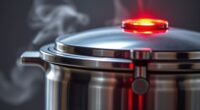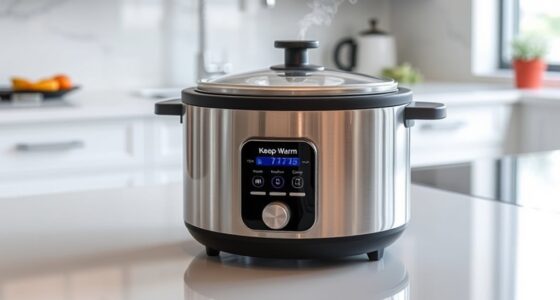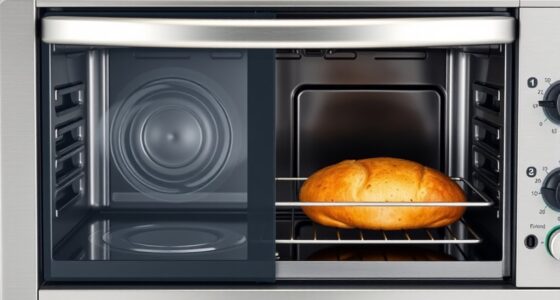To guarantee food safety in your slow cooker, always cook meats to at least 165°F and keep the temperature above 140°F during cooking. Avoid leaving food in the danger zone (40°F–140°F) for more than 2 hours, especially in hot weather. Start with preheated ingredients, monitor temperatures regularly, and refrigerate leftovers within two hours. If you follow these guidelines, you’ll prevent bacteria growth and serve safe, delicious meals every time. Keep going to discover more essential tips.
Key Takeaways
- Ensure the slow cooker reaches at least 140°F during cooking, and verify with a food thermometer.
- Cook meats to a minimum of 165°F (poultry) or 160°F (ground meats) to destroy harmful bacteria.
- Keep food out of the danger zone (40°F–140°F) for no more than 2 hours to prevent bacterial growth.
- Preheat the slow cooker properly and maintain consistent temperatures throughout cooking.
- Cool leftovers within 2 hours, store at 40°F or below, and consume within 3–4 days to ensure safety.
Understanding Safe Cooking Temperatures for Slow Cooked Foods
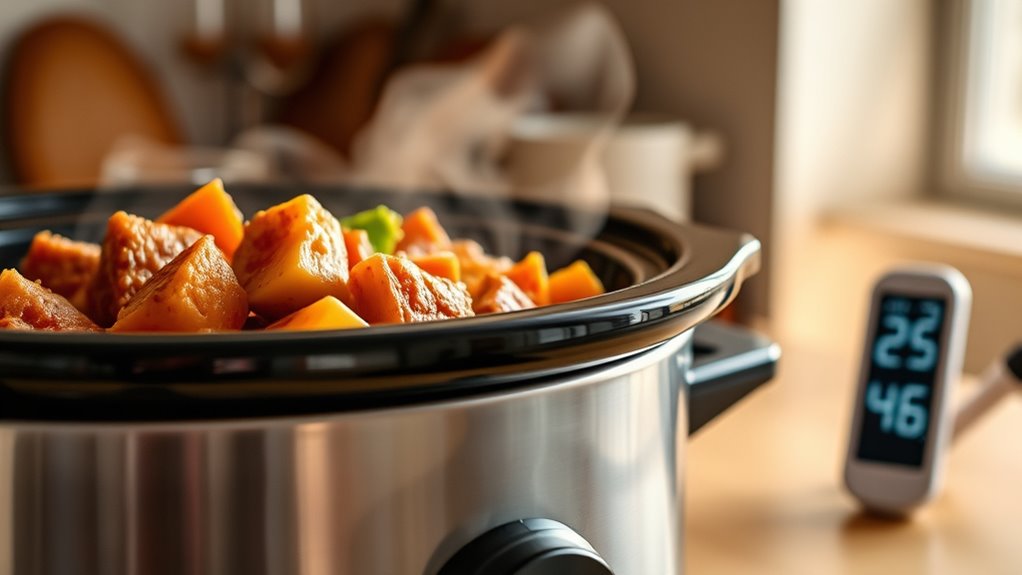
To guarantee your slow-cooked foods are safe to eat, it’s vital to understand the proper cooking temperatures. Bacteria such as Salmonella, E. coli, and Listeria can survive if foods don’t reach the right internal temperature. For most meats, like poultry, beef, and pork, you’ll want to reach at least 165°F (74°C) to ensure pathogens are destroyed. Ground meats should be cooked to 160°F (71°C). Vegetables and other ingredients generally need to be cooked thoroughly, but specific temperature guidelines depend on the type. Using a reliable food thermometer helps you verify these temperatures accurately. Remember, maintaining proper temperatures throughout the cooking process is essential to prevent foodborne illnesses and ensure your meal is both safe and delicious. Additionally, high temperature safety is crucial for achieving optimal food quality and safety standards. Ensuring your slow cooker maintains a consistent temperature can also be achieved by choosing appliances with temperature control features, which help prevent undercooking or overcooking. Properly managing cooking times and temperatures aligns with food safety guidelines, reducing the risk of illness from improperly cooked foods. Consistently monitoring internal temperatures is a key step in food safety practices to protect yourself and your loved ones.
The Importance of Proper Temperature Ranges During Cooking
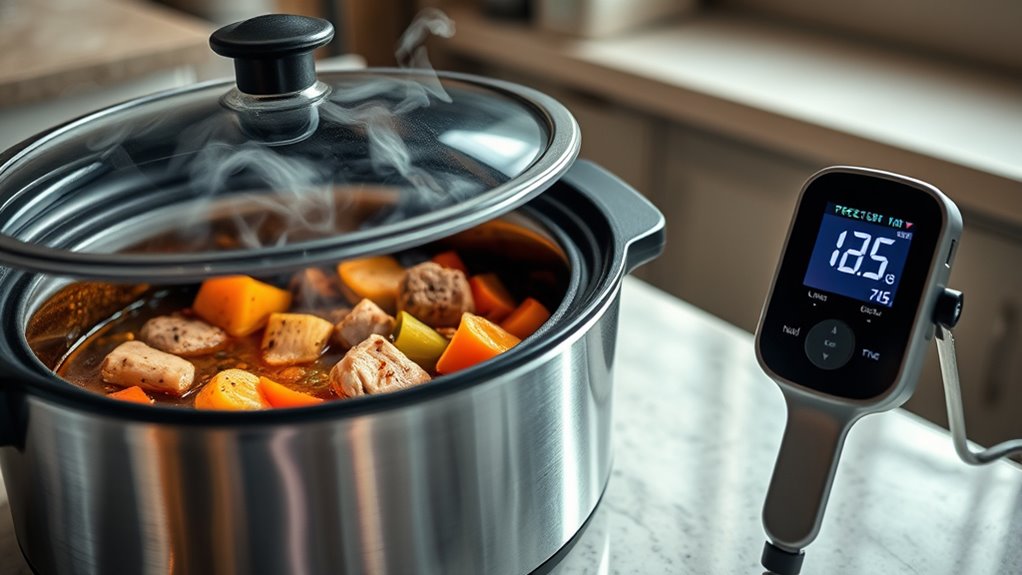
Maintaining proper temperature ranges during cooking guarantees your food reaches the levels needed to kill harmful bacteria and prevent foodborne illnesses. When you cook food within safe temperature zones, you ensure pathogens like Salmonella or E. coli are destroyed, reducing health risks. Using a reliable thermometer helps you verify that your slow cooker hits the necessary temperatures, especially for dishes like meats or stews. If food doesn’t reach the right temperature, bacteria can survive and multiply, increasing the chance of illness. Keep in mind that different foods require specific temperature ranges for safe cooking. Monitoring these ranges consistently ensures your meal is safe to eat and retains its nutritional value. Proper temperature control during cooking is an essential step in food safety and overall health. Safe cooking temperatures are critical for ensuring your dishes are both delicious and safe to consume. Additionally, understanding temperature monitoring techniques can help you better maintain the correct ranges throughout the cooking process.
How Long Can You Keep Food in the Danger Zone?

Ever wonder how long food can safely stay in the temperature danger zone? The general rule is no more than two hours. If cooked food or leftovers sit between 40°F and 140°F, bacteria can multiply rapidly, increasing the risk of foodborne illness. In hot weather above 90°F, this window shrinks to just one hour. Beyond these times, bacteria can produce toxins that aren’t destroyed by reheating. It’s vital to refrigerate leftovers promptly or keep hot foods hot in a slow cooker set at the right temperature. Never leave food in the danger zone for extended periods, especially when you’re busy or away. Staying within these time limits helps ensure your food stays safe and minimizes health risks.
The Critical Role of Initial Heating and Bringing Food to Temperature
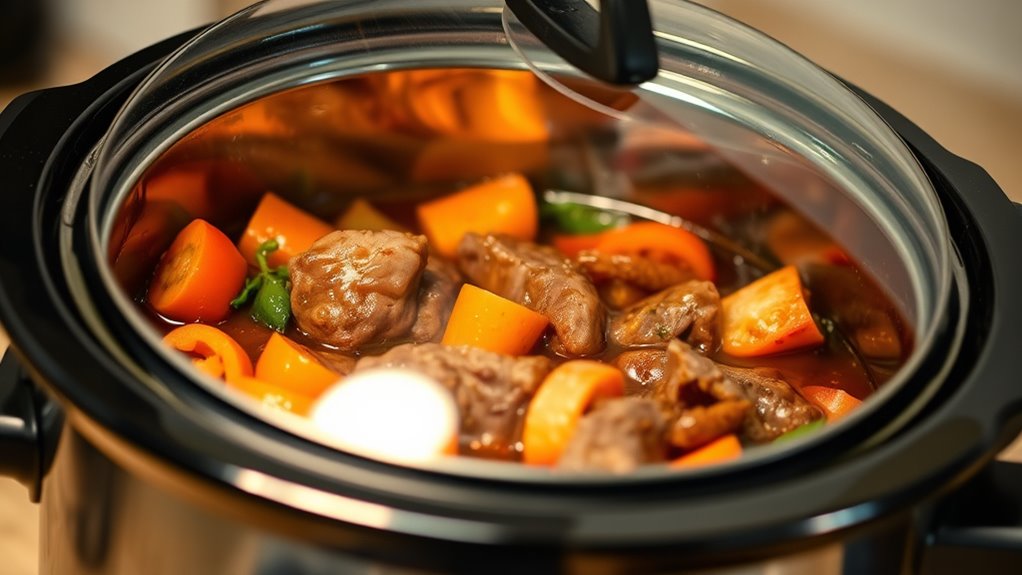
Starting with proper preheating is essential to guarantee your slow cooker reaches a safe temperature quickly. You need to bring food to the correct core temperature to prevent bacteria growth. Skipping this step can compromise food safety, so always verify your food hits the right temperature before serving.
Ensuring Proper Preheating
Ensuring proper preheating is essential for food safety when using a slow cooker. Before adding ingredients, you need to start with a hot, clean appliance to prevent bacteria growth. To do this,:
- Turn on your slow cooker and set it to high for 15-20 minutes.
- Watch for the internal temperature to reach at least 140°F (60°C).
- Use a food-safe thermometer to confirm the preheat level.
- Only then add your ingredients, ensuring they hit the right temperature quickly.
This process minimizes the risk of bacteria surviving in the cooker’s environment. Proper preheating creates a safe foundation for your meal, ensuring it stays within the safe temperature zone throughout cooking.
Achieving Safe Core Temperature
Why is achieving a safe core temperature so essential when using a slow cooker? It’s important because proper heating destroys harmful bacteria that can cause foodborne illnesses. When you start cooking, you need to bring the food to a temperature that kills pathogens quickly and effectively. If the food remains too cool for too long, bacteria can multiply, increasing your risk of illness. That’s why preheating the slow cooker and ensuring the food reaches at least 140°F promptly is critical. Use a food thermometer to check the internal temperature regularly. Once you hit the safe core temperature, hold it there to guarantee all parts of the dish are evenly cooked. Achieving and maintaining the correct temperature is key to safe, healthy slow cooking. Additionally, understanding home furnishings safety features can help ensure your equipment functions correctly and safely during the cooking process.
Maintaining Temperature During Extended Cooking Periods

To keep your food safe during long cooking sessions, you need to make certain it stays hot enough throughout. Continuously monitoring the temperature helps prevent dangerous bacteria growth. Maintaining consistent heat is key to serving safe, delicious meals. Incorporating advanced processing power from recent AI hardware innovations can help ensure your cooking appliances operate reliably at safe temperatures. Staying informed about industry transformations like AI automation can also offer innovative solutions for maintaining optimal cooking conditions. Implementing a personal finance management approach to meal preparation, such as budgeting for high-quality appliances, can enhance safety and efficiency in your kitchen. Selecting a preppy dog name can also be a fun way to personalize your kitchen gadgets or cooking accessories, adding a touch of style to your culinary space.
Keeping Food Hot Safely
Ever wonder how to keep your food safe and tasty during long cooking sessions? To do this, focus on maintaining the right temperature. First, guarantee your slow cooker stays at or above 140°F to prevent bacteria growth. Second, avoid opening the lid frequently, which lets heat escape and drops the temperature. Third, stir the food occasionally to distribute heat evenly. Fourth, use a food thermometer to check that hot foods stay consistently above 140°F throughout cooking. Additionally, proper food presentation and careful handling can also help maintain safety standards. food safety guidelines emphasize the importance of proper temperature control to prevent foodborne illness. Regularly monitoring temperature during extended cooking periods is crucial to ensure safety. Using a natural materials like linen or wood in your kitchen setup can help with maintaining a clean and safe environment. By following these steps, you keep your meal safe from bacteria and preserve its flavor and texture. Remember, maintaining the correct temperature is key to preventing foodborne illness and ensuring a delicious, safe dish for everyone to enjoy. Incorporating temperature monitoring tools can further enhance safety during extended cooking periods.
Monitoring Temperature Continuously
Maintaining a consistent temperature during extended slow cooking is essential for food safety and quality. You should regularly check your slow cooker’s temperature with a reliable thermometer to guarantee it stays within the safe zone, typically at or above 140°F (60°C). Continuous monitoring helps prevent the food from falling into the danger zone (40°F to 140°F), where bacteria can grow rapidly. If your slow cooker lacks a temperature control feature, consider using an external probe or a programmable cooker with temperature alerts. Keep the lid closed as much as possible to preserve consistent heat, but check periodically if you suspect temperature fluctuations. Proper monitoring ensures your food stays safe to eat and maintains ideal texture and flavor during extended cooking.
The Risks of Under- and Overcooking in a Slow Cooker
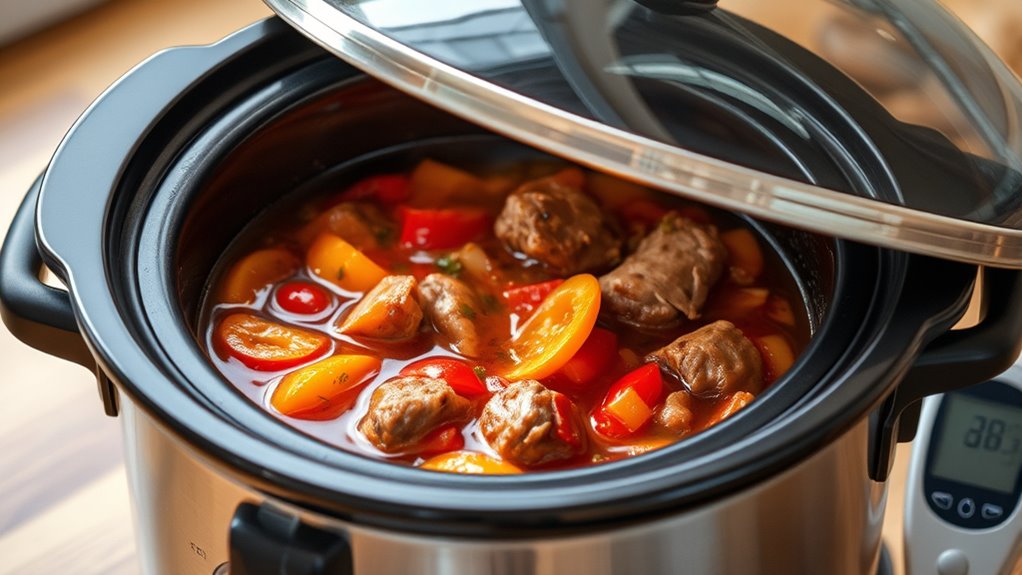
While slow cookers are convenient, under- and overcooking can pose serious food safety risks. If food doesn’t reach the right temperature, harmful bacteria like Salmonella or E. coli can survive and multiply. Overcooking, on the other hand, can cause food to dry out, develop an off-flavor, or even burn, increasing the risk of foodborne illness. Consider these scenarios:
- Undercooked chicken remaining pink and raw inside
- Beef stew sitting too long, turning mushy and unsafe
- Vegetables overcooked to a slimy, unappetizing texture
- Leftovers kept at unsafe temperatures, risking bacterial growth
Proper time and temperature control are essential to avoid these hazards and ensure your slow cooker meals are both delicious and safe. Understanding safe cooking temperatures is vital for preventing foodborne illnesses and maintaining good health. Additionally, monitoring cooking times helps prevent over- or undercooking, ensuring food safety and quality. Being aware of food safety guidelines can further help you manage risks effectively.
Best Practices for Cooling and Storing Leftovers Safely
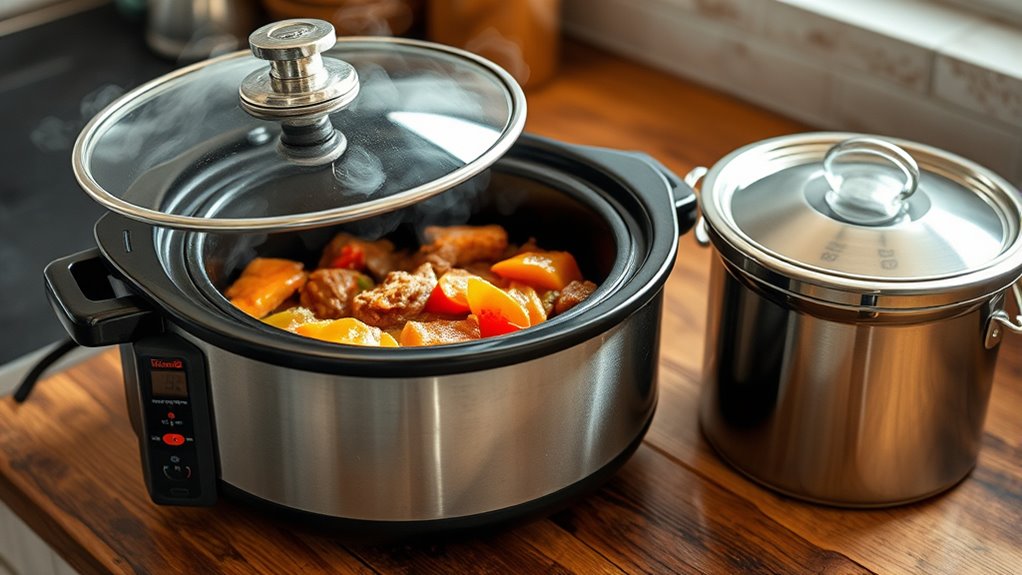
Cooling and storing leftovers properly is essential to prevent bacterial growth and guarantee food remains safe to eat. To do this, cool hot leftovers quickly—ideally within two hours—by dividing large portions into smaller, shallow containers. Store leftovers in the refrigerator at 40°F (4°C) or below, and consume them within 3-4 days. Use airtight containers to prevent contamination and keep flavors fresh. Here’s a quick guide:
| Tip | Why it matters | Example |
|---|---|---|
| Cool quickly | Limits bacterial growth | Use ice baths for large pots |
| Store promptly | Maintains safe temperature | Transfer to shallow containers |
| Label leftovers | Track freshness and safety | Date leftovers before refrigerating |
Additionally, choosing keto-friendly ingredients for meals can help maintain a healthy diet while keeping leftovers safe and nutritious.
Tips for Ensuring Food Safety Every Time You Use Your Slow Cooker
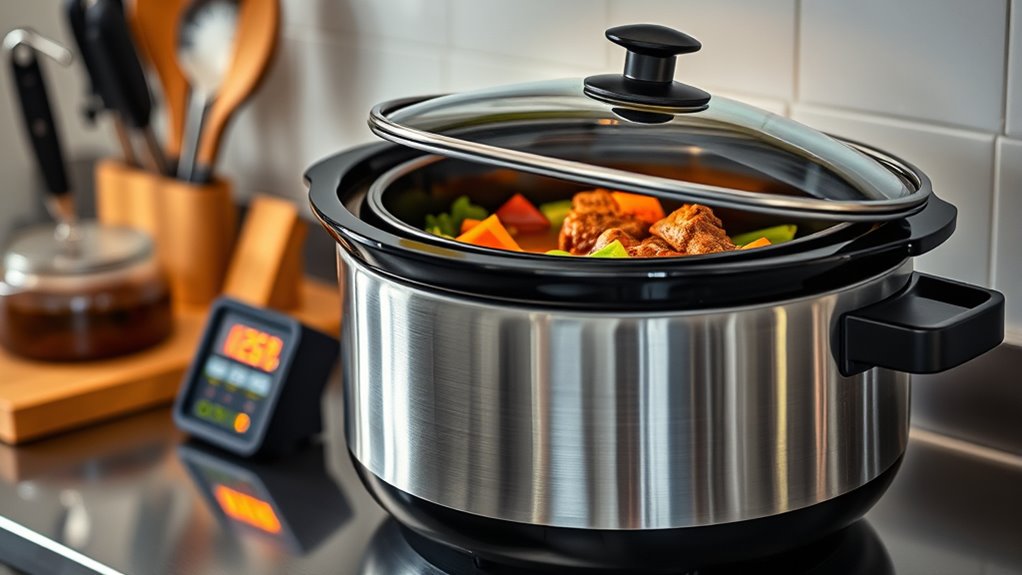
To guarantee your slow cooker meals are safe to eat every time, it’s important to follow proper handling and cooking practices. First, always start with fresh, refrigerated ingredients to prevent bacterial growth. Second, place ingredients into the cooker promptly and ensure they are evenly spread to promote uniform cooking. Third, set your slow cooker to the correct temperature—low or high—based on your recipe, and avoid the temptation to open the lid frequently, which interrupts cooking. Fourth, use a food thermometer to check that the internal temperature reaches at least 165°F (74°C) for meats and poultry. Additionally, air quality considerations in your kitchen can help reduce airborne contaminants that may affect food safety. Proper food handling practices, including washing hands and utensils, further contribute to safe cooking. By visualizing these steps—adding fresh ingredients, spreading them out, maintaining the right heat, and verifying temperature—you can confidently serve safe, delicious slow cooker meals every time.
Frequently Asked Questions
Can I Leave My Slow Cooker Unattended Overnight Safely?
No, you shouldn’t leave your slow cooker unattended overnight. It’s risky because the food might stay in the danger zone (40°F–140°F) too long, which promotes bacteria growth. Always make certain it’s set to a safe temperature and avoid leaving it on for extended periods without supervision. If you need to cook overnight, use a programmable slow cooker with a timer, and double-check it’s functioning properly before leaving it unattended.
What Are Signs That Food Has Been Overcooked in a Slow Cooker?
Signs of overcooked food in your slow cooker include a dried-out, stringy texture and a burnt smell. You might notice a mushy consistency or a color change, turning dull or overly brown. Overcooking also results in a loss of flavor, leaving dishes bland or bitter. If you see these signals, it’s time to tweak your timing or temperature to prevent further spoilage and guarantee delicious, safe results.
How Does Altitude Affect Safe Cooking Times and Temperatures?
At high altitudes, you need to increase your cooking time and temperature to guarantee food safety. The lower air pressure causes water to boil faster and at lower temperatures, which can prevent your food from reaching safe internal temperatures. To compensate, add extra cooking time and consider raising the temperature setting slightly. Use a food thermometer to verify that your dishes reach the recommended safe temperatures before serving.
Is It Safe to Add Frozen Ingredients Directly Into the Slow Cooker?
It’s not safe to add frozen ingredients directly into your slow cooker. The reason is that the food spends too much time in the “danger zone” (40°F–140°F), where bacteria thrive. Instead, thaw ingredients in the fridge or microwave before adding them. This guarantees your food heats evenly and reaches a safe temperature quickly, reducing the risk of foodborne illness. Always prioritize proper thawing methods for safe slow cooker meals.
How Often Should I Check My Slow Cooker’s Internal Temperature During Cooking?
You should check your slow cooker’s internal temperature at least once every 2 hours to guarantee food stays safe. Think of it like tending a garden—you need to monitor the soil regularly to prevent problems. For example, I once left stew unchecked, and it didn’t reach the proper temperature, risking bacteria growth. Regular checks help maintain safe temperatures, ensuring your meal is both delicious and safe to eat.
Conclusion
By mastering the dance of time and temperature, you’re the conductor of safe, tasty meals. Keep your slow cooker’s rhythm steady—bring food to the right temp, stay within safe zones, and cool leftovers promptly. When you play it by these rules, you create a symphony of flavor without risking food safety. Trust your instincts, follow the tempo, and let your kitchen sing with delicious, worry-free dishes every single time.

